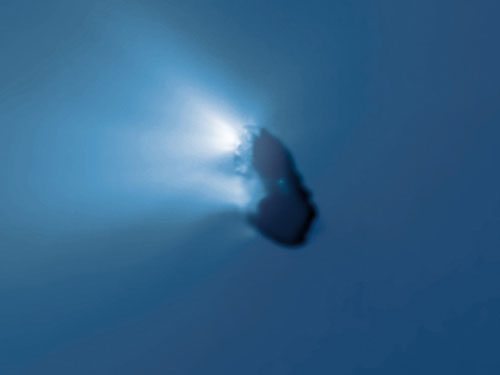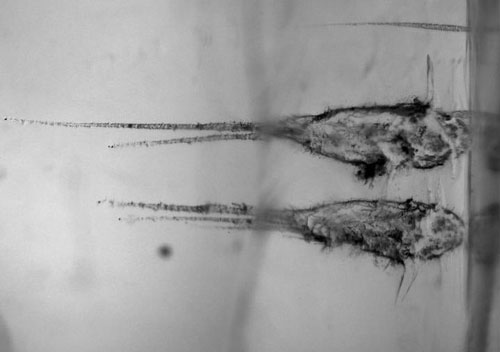| Jan 28, 2014 |
Comet under attack
|
|
(Nanowerk News) In the history of space travel, special missions to comets are rare. Nevertheless, a few unmanned space probes have delivered many fascinating results. Astronomers are now eagerly looking forward to the close rendezvous of Rosetta with comet Churyumov-Gerasimenko.
|
|
Only 14 seconds before ESA’S Giotto space probe was due to reach its shortest separation from Halley ’s Comet, it was hit: tiny dust particles which the comet ejected into space caused the whole probe to lurch; the communication to Earth was interrupted for a brief period. A short time later, the Halley Multicolour Camera, the onboard camera system, actually suffered a “deadly” hit: the instrument remained out of action for the rest of the mission.
|
 |
| A revolution in comet research: This image of Halley s Comet, which was taken on 14 March 1986 during the fly-by of ESA s Giotto space probe, shows a solid nucleus.
|
|
Despite this dramatic incident on 14 March 1986, ESA’s Giotto mission represented not only what was then European space travel’s greatest success, but also a revolution in comet research. Because hit or not - Giotto had dared to approach within almost 600 kilometres of the comet during the fly-by and had entered the coma, the cloud of dust and gas which surrounds a comet’s nucleus. The last images sent to Earth by the camera developed at the Max Planck Institute for Solar System Research provided a scientific sensation: the irregularly-shaped lump that can be seen on them proved for the first time beyond doubt that there is a solid nucleus under the coma of a comet. Before this, researchers had also thought it possible that comets consist of a rather loose accumulation of dust and smaller lumps of rock.
|
|
Until 14 March 1986, comet research had been earthbound: the view through a telescope at distant objects. This allowed trajectories to be computed, the dust and gas production to be recorded and even the chemical composition of the comet’s coma to be identified. But the comet nucleus in particular remained inaccessible, the view obscured by the coma, which eclipses everything. The only thing that could remedy this was to shift the observation site dramatically: from Earth into space. Initial plans for this were discussed by both the American and the European space agencies back in the 1970s. The most compelling argument to actually risk the adventure was provided by a comet itself: Halley ’s Comet, which was due to return into the inner solar system in 1986. Since the possibly best-known comet approaches the Sun only once every 76 years, this was a unique opportunity that scientists did not want to miss.
|
|
Further cometary missions followed the successful Halley fly-by: Giotto passed by the comet Grigg-Skjellerup six years later - albeit without a functioning camera system and thus blind - and the Deep Space 1 probe flew by Borelly’s Comet in 2001. Researchers had to wait until 2004 for images with similar detail to those obtained during the Halley fly-by, however: on 2 January the Stardust probe of the American space agency NASA approached the comet Wild 2 to within a distance of around 240 kilometres. The images of the cosmic rock impressively confirmed one of the most surprising findings of the Giotto mission: water and other frozen gases do not evaporate from the whole of the comet’s surface when it is close to the Sun. Only a small percent of the surface is active.
|
|
But Stardust did not limit itself to simply looking on. Its ambitious goal was more to capture cometary dust during the fly-by and to bring it back to Earth. The critical part of this manoeuvre is primarily the great difference in speed between comet and probe. In order that the particles, which impact onto the probe at about six times the speed of a rifle bullet, do not heat up and undergo a chemical change, they have to be gently decelerated. Blocks of aerogel, a transparent silicone foam more than 99 percent of which is made up of tiny air bubbles, turned out to be suitable dust catchers. Some two years after the fly-by, the 150 and more dust particles which had been captured entered Earth’s atmosphere on board a capsule and parachuted down to a military base in the remote U.S. state of Utah.
|
 |
| Impact traces of individual particles of comet dust in the aerogel blocks of NASA’s Stardust mission. The particles themselves can be seen as tiny black dots at the left end of the traces.
|
|
In the laboratory, the valuable freight revealed a surprise: researchers discovered that olivine, a mineral which forms only at high temperatures of more than 1100 degrees Celsius, was a component of the cometary dust. This substance cannot be assigned to the primeval matter out of which the comets formed more than 4.6 billion years ago in the icy depths of the solar system. Had there been a flow of matter from the still infant Sun to the outer edge of the planetary system as the solar system was being born? Finding olivine seems to prove those theories.
|
|
One year before the well-travelled comet dust arrived on Earth, a further comet mission had caused at least as much of a stir: NASA’s Deep Impact probe was intended to clear the view into the inside of the Tempel 1 comet on 3 July 2005 with a missile weighing more than 350 kilogrammes. The projectile impacted with a relative velocity of 37,000 kilometres per hour. However, instead of a crater, the probe flying by observed only one thing: a huge cloud of dust that obscured any view of the comet’s surface. The impact released around 3000 to 4000 tonnes of comet dust - significantly more than expected.
|
|
The huge amounts of dust produced again changed our view of the comet. It seems that the nucleus of Tempel 1 is coated not with a crust of hard rock, but with a layer of soft dust. Does this apply to all comets? How thick is the cometary dust layer? And does it hide a solid nucleus?
|
|
Only the current Rosetta cometary mission will be able to provide answers to these questions. The probe will accompany the Churyumov-Gerasimenko comet for at least a year and a half; in November 2014 its Philae lander is to touch down on the comet’s surface - in a much more gentle way than Deep Impact’s projectile. Rosetta thus opens up the next and so far most comprehensive chapter of comet research. A chapter that will surely hold a multitude of surprises - just like its predecessors.
|


